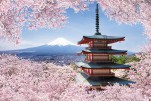Overhead the Sakura Tree

Pagodas have always been, and remain an intrinsic part of the Land of the Rising Sun. They were the first high-rise edifices in Japan. Pagoda design features, the harmony of its artistic image, and versatile symbolism certainly stand out from the general range of traditional buildings of Japan and are a recognized as a symbol of beauty and harmony in architecture.
For many centuries, mainly pagodas formed the silhouette of Japan creating high-rise dominants of the country. Even nowadays in many small towns of Japan the pagodas are major landmarks in urban space as they tower over all other ordinary buildings. They often become an embodiment of the monastery where each of them is located, and sometimes they represent the face of the entire town. It is no exaggeration to say that pagodas formed the skyline of any Japanese towns until the middle of the 20th century. Thanks to these buildings, Japanese towns have a unique and well-recognized silhouette.
In Japan pagodas started to appear after Buddhism had entered the country (6th century). A pagoda is a multi-tier tower of religious purpose and it embodies the image of the Sacred mountain as the center of the world and the world axis. Pagoda tiers symbolize the steps leading to Heaven, and the decreasing size of each upper tier compared to the previous one means the movement upwards into infinite and limitless space.
Full content of this issue you can read here
The full version of the article can be read in our printed issue, also you can subscribe to the web-version of the magazine
 Text by Nina Konovalova
Text by Nina Konovalova


